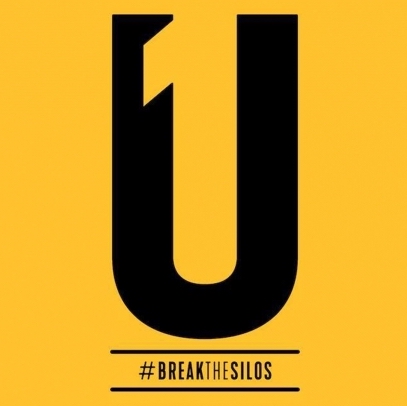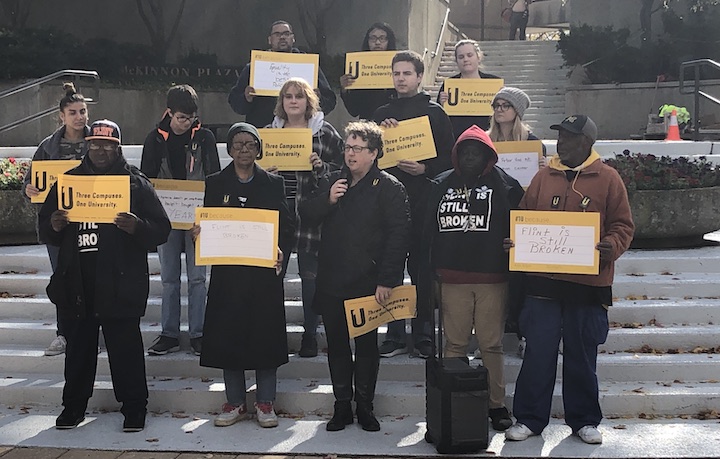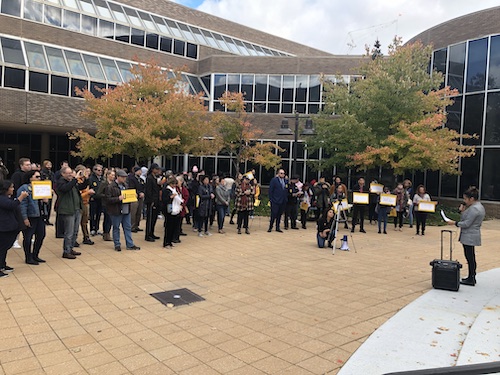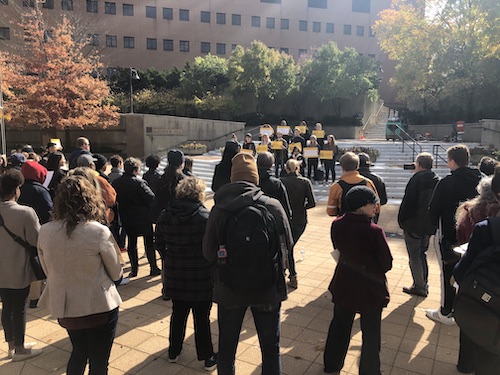 Over the past year, a coalition of University of Michigan students, faculty, and allies have formed a coalition called One University to push the university to more fully and equitably fund and support the students at their Flint and Dearborn campuses. Students at these campuses pay 80% of the tuition fees that their counterparts in Ann Arbor pay yet they receive just 25% of the per-pupil funding. As a percentage of average family income, Flint Wolverines accrue nearly three times the debt load and Dearborn students take on twice as much. A number of programs aren’t available at all to Flint and Dearborn students:
Over the past year, a coalition of University of Michigan students, faculty, and allies have formed a coalition called One University to push the university to more fully and equitably fund and support the students at their Flint and Dearborn campuses. Students at these campuses pay 80% of the tuition fees that their counterparts in Ann Arbor pay yet they receive just 25% of the per-pupil funding. As a percentage of average family income, Flint Wolverines accrue nearly three times the debt load and Dearborn students take on twice as much. A number of programs aren’t available at all to Flint and Dearborn students:
- The Go Blue Guarantee which guarantees free or subsidized tuition to any student admitted to U-M who needs it
- Funding from the $85 million U-M Diversity, Equity, and Inclusion Initiative
- On-campus medical 7 legal services
The One University coalition’s has seven goals:
- Equalize the state legislature’s per-student allocations to all campuses
- Extend the Go-Blue Guarantee to the Flint and Dearborn campuses
- Extend Diversity, Equity, and Inclusion funds to all campuses
- Pay parity for graduate students and lecturers
- Expand scholarships for low-income and working students at the Dearborn and Flint campuses to study abroad
- On-campus medical and legal services in Flint and Dearborn
- Coordinated transfers among all three campuses to make it easier for students to transfer from one campus to another
Yesterday, One University coalition members, primarily the students, held a rally on the Flint campus to highlight their efforts. The rally featured multiple speakers from both the university as well as allies in the local community. Because the Washtenaw County Democratic Party (of which I am the Chair) passed a resolution at their September General Membership meeting in support of the One University coalition’s goals, I was one of them. The speakers were:
- U-M Flint Students Lucine Jarrah, Alysia Treviño, and Courtney Hibbeln
- U-M Ann Arbor Student Solomon Medintz
- U-M Flint Assistant Professor of Anthropology Dan Birchok
- State Reps. John Cherry (via a Representative) and Sheryl Kennedy
- Laura McIntyre, Member of the Flint Democracy Defense League
- Aurora Sauceda, Chair, Latinos United for Flint
- Chris Savage, Chair of the Washtenaw County Democratic Party
- Shaun Crawford, UAW member



Following the rally, many of the attendees also attended the U-M Board of Regents meeting and many of us spoke there, as well. Speakers at the Regents meeting were:
- Lucine Jarrah
- Brooklyn Golden, President of the U-M Flint Black Student Union
- Daniel Birchok
- Chris Savage
- Kieth Flynn, Chair of the Genesee County Democratic Party, a group that was the first Democratic Party organization to pass a resolution in support of the One University initiative
While all of the speakers had a different perspective, they shared a common vision and desire to “break the silos” that exist because of the disparities that exist between the three campuses. The university has ONE president and ONE Board of Regents yet they operate the three campuses as if they are three separate institutions. Keep in mind that University of Michigan’s budget is in the BILLIONS of dollars and their unrestricted reserves are over $4 billion. That’s not all from the state higher education contribution and how it gets spent in the future is largely determined by the Board of Regents and the administration itself.
Following the Board of Regents meeting, I spoke to one of the Regents, seven of the eight of which are Democrats. They told me that their focus is on outcomes, primarily graduation rates. The Go Blue Promise, they said, is similar to the Kalamazoo Promise which guarantees free college education for all students who graduate from Kalamazoo schools. According to this Regent, while it has increased the number of students enrolled in college after graduation, it has not moved the needle on graduation rates. This was their justification for not extending the Go Blue Promise to Flint and Dearborn students. They also said that college affordability was not the reason for low graduation rates in Flint and Dearborn so other goals of the One University initiative are not likely to impact these outcomes. Finally, the claim that amount of money they are allowed to spend in Flint and Dearborn is out of their hands, determined by line items in the money they get from the state, determined by the state legislature.
I understand that policy decisions should be made based on data and that there are myriad reasons why students do not complete their college education and graduate. However, if these programs are deemed worthy for Ann Arbor students, it simply makes no sense why they wouldn’t be equally, if not MORE, beneficial for Flint and Dearborn students. At any rate, it’s important that we push them to improve the equity between the three campuses so that, in U-M President Mark Schlissel’s own words, U-M can ensure that their community “allows all individuals an equal opportunity to thrive.”
For more information on the One University coalition’s work, follow them on Twitter at @OneUniversityUM, on Facebook at OneUniversityUM, and join their mailing list by clicking HERE. Extensive information about their goals with supporting documents can be found HERE.



